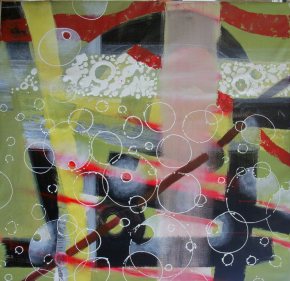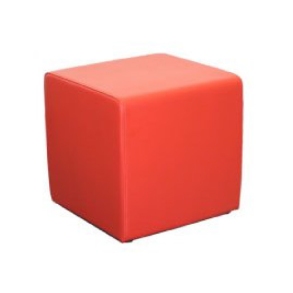The secret: go with the flow of whatever we are presented. Take the action. Decisions create energy and fuel vision. Example: I am painting abstracts – what a great way to find our inner creative voice. So I look at a piece and I get an image of adding a big red circle to the moves I have already made…. Ugh, really? ….Banal… Is that as creative as I can get?…. Then I get about 5 more seemingly unworthy ideas which I likewise push to the side because of this or that, and… that’s about when the creative voice decides that if I am not going to play, neither is the creative voice. No more moves…. End of creativity…..yep, there is nothing now……. OK, we obviously need to try a new approach. How about going with what ever bubbles up then? I hoist another piece on the easel….. “Dark vivid line right through the whole piece”. Really? OK then. Vivid line coming up….what color? “Brown” ….Uh….not my favorite color here, just sayin, but OK, brown line coming up. Oh wow, all the circular elements in the piece line up on this vivid line…. and oh wow, the other lines now work with the vivid line to add an element of perspective…. I realize my lesson is that THIS is how to get beyond where I was, beyond my paltry bag of marks that defined me a moment ago. Having trust in the creative voice immerses us in a new world of NEW marks. A door has opened beyond which lies an endless vocabulary of NEW moves. Our love affair with Control is left at the threshold of THIS door. Peter Gabriel is singing on my iTunes “without my pride…I reach out from the inside“. I walk through and I am afloat in Pure unadulterated Discovery. I am excited. Every once in a while when I can forget thinking about what I am doing, I get the most wonderful butterfly sensations – the vibration…the connection…… I get it. Basically the creative voice figures that if I cannot follow a simple instruction of a big red circle – how can I follow magnificent instruction? I would be overwhelmed. The big red circle is a big red training wheel. My actions and the Creative reactions are the fuel of creativity. So much of this is about acceptance. There are no mistakes. We cannot see so far ahead to know what is a mistake or what is simply a new foundation, so we trust that the moves we make now are the foundation of the new final piece, even though we cannot see the final piece now, and no matter our pride. I am having a thought to rotate the piece, and ….. wow….a whole new concept appears….an archway to somewhere….I had no idea that I was painting this. I know I am on the right path when my day is filled with wows. “Bubbles”…… Really?….In fine art?….OK, “without my pride” bubbles coming up, lots of them……where to next?……
The Red Circle – Finding Your Creative Voice
Filed under Art Insights
The Observer Function: Observer Error or Observer Effect?
 Observer Error or Observer Effect? – How do we reconcile the role of the Observer(s) in Classical and Quantum Physics? In a nut shell, it seems that we need an “Observer Function(s)”. In classical physics, the observer function(s) would approach 0, and in quantum physics, the observer function(s) would have a value(s) that relate to what in math is referred to as a translation.
Observer Error or Observer Effect? – How do we reconcile the role of the Observer(s) in Classical and Quantum Physics? In a nut shell, it seems that we need an “Observer Function(s)”. In classical physics, the observer function(s) would approach 0, and in quantum physics, the observer function(s) would have a value(s) that relate to what in math is referred to as a translation.
Classical physics is “observer Independent”. When we do get an effect caused by the observer, we call the involvement of the observer “observer error”. So, for our purposes here, the observer function(s) would be 0 if we have no observer error. On the other hand, Quantum Physics does not have to be observer dependent, but when it is, and it frequently is, we call it not an “error” but an “observer effect”. Why the discrimination?
Well, what we call the observer(s) is basically another term for a “detector(s)”, really. And in classical physics, we set up a detector(s) independent of the observer. But the detector could just as well be the human sense of touch, smell & taste, sight, hearing, balance – it’s just that the observer as detector does not have a reliable and replicable quantifiable scale, so we create detectors that do. We call them pressure gauges, pH meters, photographic film, oscilloscopes, and scales respectively, among others. And the spatial relationships between detectors and the objects matter – electron microscopes don’t work at 50 meters for example. Just so, the observer could be used as a detector (and in Einstein’s reference frames it somewhat is) but the relationship of the observer to the object would have to be as well defined as we now define the relationship of the object to the detectors in classical physics.
Let’s look at an example in art & physics: Let’s just measure the color of a simple red cube. Classical physics might say that all sides of the cube are “red”. But describing the result as “red” is akin to “absolute value”, which is the same as saying “observer independent”. And the problem with that is that our measurement would include more than absolute values in our 3D environment; our measurement would include absolute values, something we can call “illusions”, and a combination of the 2. Depending on the angles of the “light to the red cube to the observer”, very crudely we can get multiple color measurements other than just red:
- the top of the cube can measure as “pink” and an artist would call this a “highlight” or a tint,
- a side can measure as “red” and an artist would call this “local color” or a hue,
- and another side can measure as “brown” and an artist would call this “shadow” or shade.
I have quite a bit of experience with what we call classical experiments, but I ask this now – in what step of the scientific method do we consider the permutations of the variations of results caused by these relationships of the Object:Detector:Signal? We don’t in classical physics. In Classical Physics the results are all absolute value (reality) based, with the illusion aspect at 0 value.
Quantum physics on the other hand is more adept at handling the results of this red cube measurement(s). We could use probability to get a permutation for the colors of the cube as we vary the conditions or angles between the Object:Detector:Signal (cube:observer:light). But the result would in no way be a single “absolute value” result. The “result” would consist of a number of colors according to the probabilities of the set-up.
So now that we have considered how to measure a red cube using classical versus quantum physics, Consider this question: When we perform the double slit experiment and get this “single repeatable result”, are we looking at the “classical red cube” or are we looking at just ONE of the other probable permutations available through a more quantum approach that considers the relationships of the light:object:detector? And which one? And if we are looking at just ONE of numerous probabilities – where are the other permutations? (Other permutations in our example include the highlight, local color and shadow for a start, but in our 3D reality, there are 27 possible result types). I propose that the classical double slit experiment result is but ONE possible result out of numerous permutations on the experiment. Elucidating some of the other results will open the door to certainty in quantum physics, because once we realize the additional variables involved, we can calculate them without having to resort to reverse engineering the system from the probabilities of the results.
And why do I keep including plural observer(s)? Well, that gets into the next blog on “What is Reality?” and how can we utilize Realities classified into dimensions to demystify the difference between classical and quantum physics. We will use a Necker Cube as our art & physics example.
Filed under Observer
